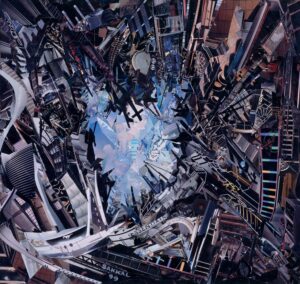
“Annie Is Home from the Sea” by George Sakkal
Cognitive Unconscious Visualism, or Cognitive Unconscious Visual Creativity, is the newest breakthrough in understanding the human mind as it relates to creating visual Fine art. Cognitive Unconscious Visualism is summed up in the term CUVISM, coined by the discoverer himself, collage artist George Sakkal. Below is a closer look at what CUVISM is, the science and thinking behind it, and what it means for the art world.
Cognitive Unconscious Visual Creativity
Cognitive Unconscious Visualism is the name for the subconscious neurological process in the brain that ultimately drives human creativity. It is the name for how the mind works fundamentally in creating art, and deems this process to be innate in every human being. From the cave painters to the oil painters to the collage artists, everyone has that quality for creativity.
The Science & Thought Behind CUVISM
This discovery supports the modernist art theory of Paul Cézanne, which posed that Fine art derived from the subconscious mind as opposed to the conscious. It directly refutes the opposing, Postmodernist theory of Marcel Duchamp, who believed that creating art was a conscious act. CUVISM brought these theories to the test by putting them in light of hard, scientific data, showing that the modernist art theory is correct.
According to the research of collage artist George Sakkal, neurologic study concerning decision-making proves that producing visual creative art is indeed subconscious; it is an outpouring of one’s experiences and skill that is stored in the memory. One can learn about the details of these art theories and Sakkal’s research and conclusions in his book, CUVISM: Cognitive Unconscious Visual Creativity.
Practical Applications of CUVISM
What does this discovery mean for the art world? Its implications have a ripple effect not yet fully known so early in its discovery, but its consequences are far-reaching. It changes the art world via education, methodology, and our understanding of human beings. Those who have learned that Marchel Duchamp’s theory is correct will need to take this new data into consideration; art educators will need to reframe their teaching on art theory and methodology. Instead of taking on a conscious approach as the Postmodernists did, artists today can make leaps and bounds in the pursuit of creating Fine art through utilizing their own Cognitive Unconscious Visualism.
CUVISM Art
The works of George Sakkal are a tangible display of CUVISM at work. All of his collage art is done through the subconscious process. Sakkal turns his paintings around and around, letting his innate creativity, CUVISM, work at its fullest. The result is a beautiful and imaginative portfolio of art in different styles.
Explore the Art and Works of George Sakkal
CUVISM engages by way of a search and discover methodology. It totally rejects Postmodern’s predetermine readymade ideology; a conscious mind preconceived conceptual art theory, a theory and practice Sakkal has proven to be fallacious and damaging to the creative mind of all artists who subscribe to its use. To learn more about CUVISM, acquire George Sakkal’s 2015 book, CUVISM: Cognitive Unconscious Visual Creativity The Human Response, available at amazon.com, and his new book, An Era of Chaos: In Seach of Cultural Truth. His new book, available at most bookstores and from Amazon.com, provides scientific evidence proving Postmodern art reasoning is wrong.